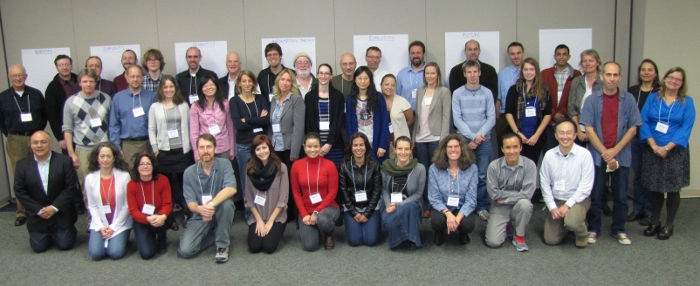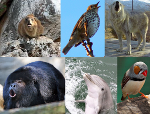| Description | Participants | Agenda | Summary | Products |
|---|
NIMBioS Investigative Workshop
Analyzing Animal Vocal Sequences

Topic: Multidisciplinary approaches to analyzing animal vocal communication sequences
Meeting dates: October 21-23, 2013
Location: NIMBioS at the University of Tennessee, Knoxville
Organizers:
Dan Blumstein, Ecology & Evolutionary Biology, Univ. of California, Los Angeles
Marie A. Roch, Computer Science, San Diego State Univ.
Arik Kershenbaum, NIMBioS, Univ. of Tennessee, Knoxville
Objectives: The aim of this workshop is to bridge the gap between mathematical and biological researchers with an interest in the quantitative analysis of animal vocal sequences. Recent developments in the mathematical analysis of complex animal communication have generated opportunities to understand the functional aspects of animal vocalizations, their role in social organization, and ultimately to explore the origins and evolution of human language. Until now, however, the collaboration between mathematicians/computer scientists and biologists/zoologists in this field has been very limited. We aim to define the state of the art in this field, explore new horizons for collaboration, and provide new techniques through a synthesis of the mathematical and biological approaches to communication analysis. We will also use this unique gathering to define some of the key questions that need to be posed to address ultimate and proximate hypotheses about behavior, in the context of animal vocal communication systems.
Biologists can benefit from a broader set of tools and methodologies, whereas mathematicians can use the input of biologists to channel their research towards more biologically meaningful hypotheses. Current tools have brought us only so far in the analysis of vocal signals; new techniques such as analysis of non-linear phenomena, syntactic analysis, and network analysis, are necessary to move the field forward.
This workshop that will take a first step towards building a coherent community of researchers of animal vocal sequences, with a well-defined framework for collaborative research and consistent hypothesis-driven paradigms. It will bring together researchers specializing on key animal taxa (such as cetaceans, bats, song birds, etc), biologists investigating animal communication in general, cognitive psychologists and computational linguists, and mathematicians and computer scientists with specialist knowledge of key algorithms and analytical principles. The structure of the workshop will be highly interactive, with repeated sessions of one or two talks plus question and answer sessions, followed by break-out groups in which existing techniques can be scrutinized and new ideas floated. Four main subjects will be addressed:
- state of the art in computational techniques;
- finding common terminologies and comparative computational metrics;
- defining the mathematical aspects of the important behavioral/evolutionary questions; and
- specific computational challenges in the investigation of communication complexity.
We expect this workshop to provide biologists with a practical understanding of the methodologies available to them, to provide mathematicians with an understanding of the requirements of biologists in the development of new techniques and algorithms, and consequently to generate genuine collaborations between participants for continuing research. This synthesis is likely greater than the sum of its component parts – not only generating new ways of analyzing behavior, but possibly also new theory about behavior and behavioral interactions.
Descriptive Flyer (pdf)
Analyzing Animal Vocal Sequences WordPress site
 Summary Report.
The first phase of the meeting consisted of sessions of two-to-three short talks, followed by extended discussion time. A total of 10 talks was given. In the second phase of the meeting, the participants self-organized into six working groups, with each group intended to collate and synthesize information on a specific sub-topic of the field. The groups were: Evolution, Language, Meaning, Structure, and Acoustic units. The intention was that each group would generate a draft section of a manuscript that would provide a comprehensive review of the analysis of animal acoustic sequences. Immediately following this, the organizers collated these drafts into a single manuscript, which is currently in revision following peer-review. Future plans are to propose a NIMBioS working group based on the collaborations that have arisen from the workshop.
Summary Report.
The first phase of the meeting consisted of sessions of two-to-three short talks, followed by extended discussion time. A total of 10 talks was given. In the second phase of the meeting, the participants self-organized into six working groups, with each group intended to collate and synthesize information on a specific sub-topic of the field. The groups were: Evolution, Language, Meaning, Structure, and Acoustic units. The intention was that each group would generate a draft section of a manuscript that would provide a comprehensive review of the analysis of animal acoustic sequences. Immediately following this, the organizers collated these drafts into a single manuscript, which is currently in revision following peer-review. Future plans are to propose a NIMBioS working group based on the collaborations that have arisen from the workshop.
Products
Publications
Kershenbaum A, Garland EC. 2015. Quantifying similarity in animal vocal sequences: which metric performs best? Methods in Ecology and Evolution. [Online]
Ferrer-i-Cancho R. 2014. Optimization models of natural communication. Physics and Society, arXiv:1412.2486. [Online]
Kershenbaum et al. 2014. Acoustic sequences in non-human animals: A tutorial review and prospectus. Biological Reviews.
Presentations
Waller S. March 2015. Cats talk back: Feral & socialized. Living with Animals Conference, Eastern Kentucky University.
Waller S. 23 April 2014. Coyote consciousness: Social predator vocalization and communication. Toward a Science of Consciousness Conference, Tucson, AZ.
Grants/Proposals
Waller S. Pending (2016). Cooperative Predator Vocalization Consortium: Wolves in Yellowstone, NSF REU.
NIMBioS Investigative Workshops focus on broad topics or a set of related topics, summarizing/synthesizing the state of the art and identifying future directions. Workshops have up to 35 participants. Organizers and key invited researchers make up half the participants; the remaining participants are filled through open application from the scientific community. Open applicants selected to attend are notified by NIMBioS within two weeks of the application deadline. Investigative Workshops have the potential for leading to one or more future Working Groups. Individuals with a strong interest in the topic, including post-docs and graduate students, are encouraged to apply. If needed, NIMBioS can provide support (travel, meals, lodging) for Workshop attendees, whether from a non-profit or for-profit organization.
A goal of NIMBioS is to enhance the cadre of researchers capable of interdisciplinary efforts across mathematics and biology. As part of this goal, NIMBioS is committed to promoting diversity in all its activities. Diversity is considered in all its aspects, social and scientific, including gender, ethnicity, scientific field, career stage, geography and type of home institution. Questions regarding diversity issues should be directed to diversity@nimbios.org. You can read more about our Diversity Plan on our NIMBioS Policies web page. The NIMBioS building is fully handicapped accessible.
NIMBioS
1122 Volunteer Blvd., Suite 106
University of Tennessee
Knoxville,
TN 37996-3410
PH: (865) 974-9334
FAX: (865) 974-9461
Contact NIMBioS


